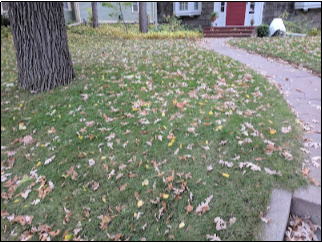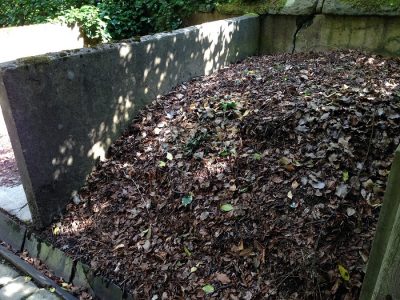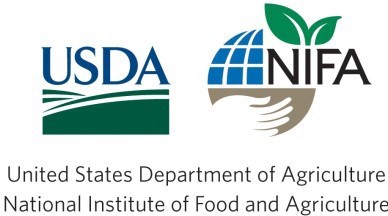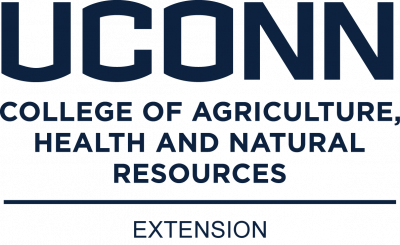The disposal of leaf litter in fall can be a labor-intensive task, but fallen leaves can provide an untapped and valuable nutritional amendment. Just as returned turfgrass clippings provide nutrients to the lawn, fallen leaves can supply organic matter and nutrients to the lawn and landscape beds, contributing to reducing the maintenance efforts of a low-input sustainable landscape. Mulching a 2” layer of fallen leaves into the turfgrass canopy over the course of the fall season adds approximately 150 lbs. of nitrogen, 20 lbs. of phosphorus, and 65 lbs. of potassium per acre (equal to approximately 3.44 lbs. of nitrogen, 0.46 lbs of phosphorus, and 1.49 lbs of potassium per 1,000 sq. ft.) (Ferree, 2016).
For mature established turfgrass lawns where rapid recovery from traffic injury is not a priority, the rate or amount of a fall fertilizer may be reduced or eliminated by annually incorporating finely chopped leaf litter into the turfgrass lawn canopy. When mulched, the very fine leaf fragments will quickly decompose and mineralize (the natural process of nitrogen release from organic matter into forms that are available to turfgrass plants), resulting in less reliance on supplemental fertilizers.
Successful leaf mulching requires more frequent mowings to sufficiently reduce the leaves to a size small enough to settle into the turfgrass canopy without covering the leaf blades. Sunlight must be able to penetrate through the fallen leaf layer while turfgrass plants are still actively growing. If the chopped leaf layer is too thick or the mulching fragments too large, then the turfgrass plants can be deprived of sunlight needed for growth at a time when the intensity and duration of available sunlight is diminishing.

On Turfgrass Areas:
- Mulching finely chopped tree leaves into an existing turfgrass stand may be considered part of a leaf-litter disposal strategy.
- Mulching mowers cut and shred leaves during the mowing process. These machines can easily finely chop up to 6” of leaves at a time.
-
- Traditional mowers can be used by raising the mower deck to the highest setting and making several passes over the area in a crisscross pattern.
- Frequent mulching of leaves is recommended. Mow at the correct height of cut, removing no more than 1/3 of the leaf blade during each mowing event. To keep finely mulched leaves in the turfgrass canopy, the frequency of fall mowing events may need to increase (Figure 1).
- Finely mulched leaf fragments will provide the lawn with essential nutrients, retain more moisture, shade the soil surface to reduce the germination and growth of winter annual weeds, moderate the soil temperature as the weather cools, and provide a continued source of food for soil microflora actively feeding on the decomposing organic matter.
- Fallen leaves can block sunlight and limit turfgrass growth, so no more than 20% of the turfgrass lawn should be covered by tree leaves after each mulching event (Figure 2) (Trappe, 2018).
- Fallen leaves are an excellent source of carbon, and most deciduous leaves are composed of approximately 2% nitrogen (Trappe, 2018). When mown into lawns, leaf particles mix with grass clippings. Both break down quickly and efficiently, and combined, create a compost of optimal composition.
- If a thick layer of leaves remains on the top of the turfgrass surface during the late fall and winter, it will provide an environment that may encourage disease (snow mold), which may subsequently thin or kill the turfgrass canopy.
- In the spring, any layer of remaining leaves will slow spring green up and delay active growth, as the leaf mulch blocks the sun from warming the turfgrass surface. Therefore, an early spring clean up of the turfgrass surface will encourage healthy growth.
- Research has shown that mulching leaves into the turfgrass canopy increases organic matter at the soil surface, but does not contribute to the direct buildup of thatch (Horton, 2014). Thatch is composed of portions of the turfgrass plant (rhizomes, stolons, senescing leaves) that accumulate at the soil surface and are slow to decompose. Thatch is a normal component of an actively growing turfgrass system. Some species develop thatch more rapidly than other species. Regular maintenance to manage thatch is important in both athletic field and non-athletic field settings. In areas of heavy wear, such as athletic fields, thatch can increase the resilience of the turf canopy.
- Always mow the lawn and fallen leaves when the turfgrass canopy is dry. Wearing a dust mask is recommended to avoid inhaling small particles.
- Mulch mowing up to tall vegetation or woodland edge may help to reduce tick habitat (Wickings, 2015).
- Variations in the degradation process of leaves based on tree species has been observed. Leaves of ash and maple are more difficult to mulch than oak leaves (Trappe, 2018).

In Landscape Beds:
- If mulched fallen leaves are desired around plants in landscape beds, use a mulch mower with a bag component to collect, transport, and disperse the mulched leaves with minimal effort.
- Whole unshredded leaves can also be distributed or left unmown, if desired. Preserving intact leaves, to which insects may have become attached, protects and allows beneficial insects to complete their life cycle within the garden. Many beneficial insect species rely on fallen leaves for protection during winter (e.g., many insect species spend the winter months protected in leaf litter as cocoons or pupa).
- Whether finely chopped or whole, distribute leaves around plants in a 4-6” layer, while maintaining a 6” circumference space around the crown of each plant. This space allows moisture the opportunity to filter easily into the soil, while also preventing damage from rodents or suffocation of the roots. A heavily mulched landscape bed may provide an environment that attracts voles and other burrowing pests.
Collected leaves can also be composted or piled in out of the way locations to allow them to break down over time (Figure 3).

Pest Management Considerations:
Correct leaf management plays an important role in pest management strategies within a sustainable landscape.
There may be circumstances when mulching with leaves may not be beneficial. Overwintering insect pests, disease pathogens, and weed seeds may be protected in leaf litter. If insects or diseases have been a repeated problem, it may be necessary to temporarily bag and dispose of leaves in the trash to reduce future outbreaks. Always follow local municipal yard waste regulations.
Jumping worms can be moved around the property by moving leaves from one area to another or adding them to compost. If jumping worms are present on the property, avoid moving infested leaves into uninhabited areas.
View the pdf version of this document here.
Sources
- Ferree, R. (2016). Recycled leaves make inexpensive mulch. University of Illinois Extension. aces.illinois.edu/news
- Nikolai, T., Rieke, P. & McVay, N. (1997). Leaf Mulch Forum: Research and Real-World Techniques. Crop & Soil Sciences Department, Michigan State University. archive.lib.msu.edu
- Horton, J. (2014, August 15). Fall is a beautiful season, but leaf me alone! Alabama Turf Times. Fall. p. 14-19. https://issuu.com/leadingedgepubs/docs/al-turf-times-2014-fall/14
- Wickings, K., Bonhotal, J., Schwarz, M. & Lampman, J. (2015). The Effects of Mulching Leaves in Place on Tick Populations in Lawns and Parks. New York State IPM Program. ecommons.cornell.edu
- Trappe, J. (2018, October 13). Should I mulch or bag my leaves? University of Minnesota Extension. blog-yard-garden-news.extension.umn.edu
Questions? Contact:
Vickie Wallace
UConn Extension
Extension Educator
Sustainable Turf and Landscape
Phone: (860) 885-2826
Email: victoria.wallace@uconn.edu
Web: ipm.uconn.edu/school
Photos by Alyssa Siegel-Miles and Victoria Wallace.
The information in this document is for educational purposes only. The recommendations contained are based on the best available knowledge at the time of publication. Any reference to commercial products, trade or brand names is for information only, and no endorsement or approval is intended. UConn Extension does not guarantee or warrant the standard of any product referenced or imply approval of the product to the exclusion of others which also may be available. The University of Connecticut, UConn Extension, College of Agriculture, Health and Natural Resources is an equal opportunity program provider and employer. UConn Extension is committed to providing equal access and full participation for individuals with disabilities within all our programs and activities. Visit s.uconn.edu/accessibility for more resources.
  |